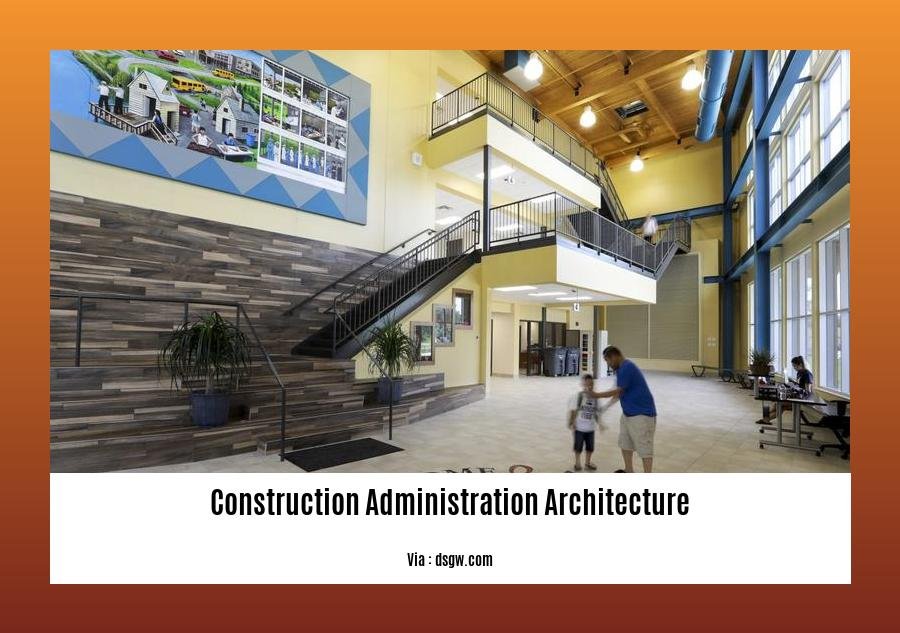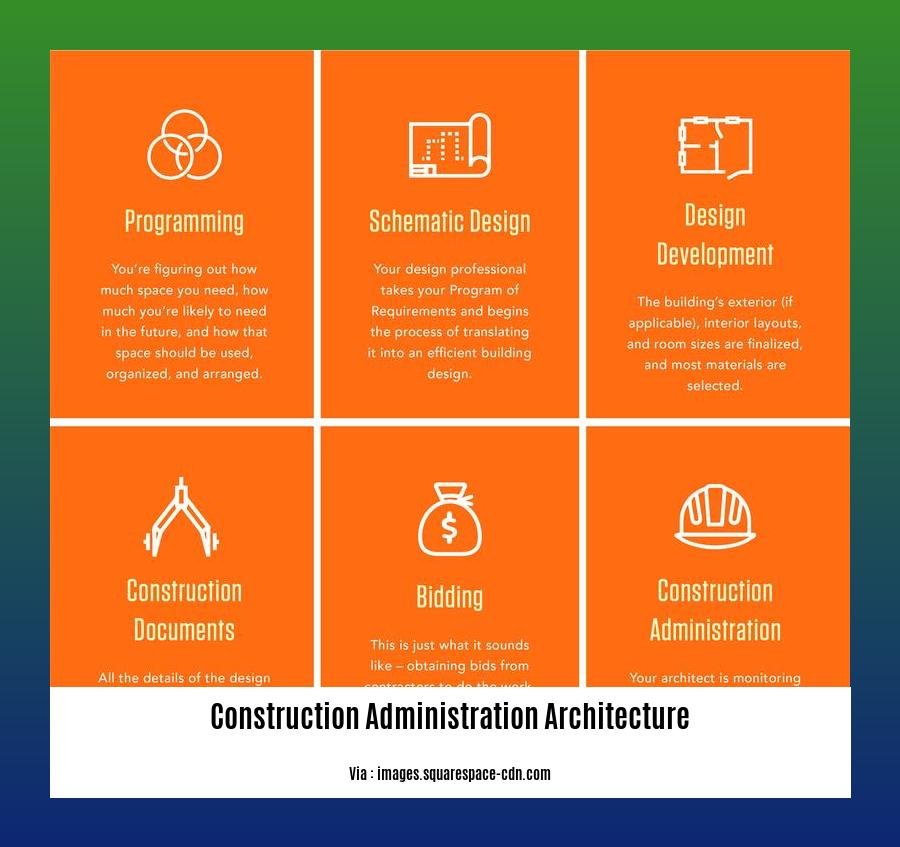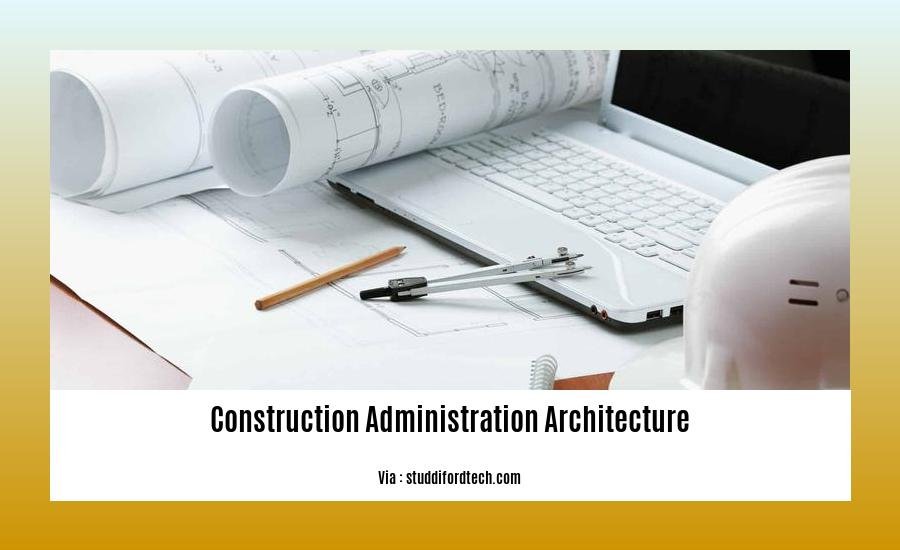Delve into the intricate world of construction administration architecture, where meticulous planning, coordination, and execution are paramount to unlocking successful project delivery. This comprehensive guide explores the essential pillars of construction administration, encompassing contract management, quality control, project scheduling, and cost control.
Key Takeaways:
- Construction administration involves coordinating and overseeing the contractor’s work.
- Architects review project flaws, provide suggestions, and inspect construction.
- Architects assess submittals and drawings to ensure they align with design requirements.
- Construction administration encompasses the oversight of the project’s construction phase.
Construction Administration Architecture: A Guiding Framework for Project Success

Pre-Construction Planning
Laying the groundwork for a successful project begins with meticulous construction document development. These documents serve as the blueprint for construction, ensuring a shared understanding between all stakeholders.
Next, bidding and contracting establish clear agreements and responsibilities. Careful selection of contractors through a transparent process is crucial for a smooth construction phase.
Site selection and preparation involve selecting an optimal location and preparing it for construction. Factors such as accessibility, soil conditions, and environmental regulations need to be carefully considered.
Scheduling and budgeting provide a roadmap for timely and cost-effective completion. A well-defined schedule and budget allow for proper planning, resource allocation, and risk mitigation.
Construction Phase
During construction, site supervision and coordination ensure that the work aligns with the design intent and project specifications. Regular site visits, progress monitoring, and communication with contractors are essential.
Contract management and administration involve managing contracts, resolving disputes, and administering change orders. A thorough understanding of contractual obligations and legal implications is crucial for effective contract management.
Quality control and assurance processes ensure that construction meets the desired standards. Regular inspections, material testing, and adherence to building codes are essential for delivering a high-quality product.
Change order processing manages modifications to the original design or construction scope. Evaluating the necessity, impact, and cost of change orders is crucial for maintaining project integrity.
Inspection and testing verify that the completed construction meets specifications. Final inspections, commissioning, and performance testing ensure that the project meets safety and functional requirements.
Post-Construction Closeout
Punch list preparation and completion involve identifying and addressing any outstanding issues or deficiencies. A comprehensive punch list ensures that the project is completed to the client’s satisfaction.
Final inspections and documentation provide a comprehensive record of the construction process. This documentation includes as-built drawings, inspection reports, and certifications.
Warranty and maintenance administration ensure that the project is free from defects and performs as intended. Regular maintenance and inspections help extend the life and functionality of the building.
Project closeout and handover transfer the completed project to the client. This includes providing all relevant documentation, training on building systems, and establishing a maintenance plan.
Looking to expand your business in the construction industry? Check out our guide to business development in construction industry for tips and strategies.
If you’re looking for reliable and efficient cargo services in qatar, be sure to explore our offerings.
Need some inspiration for your new business? Discover unique and memorable company name ideas malaysia that will make your brand stand out.
For those seeking employment in the construction sector, browse our list of construction companies in ghana with vacancies to find your next career opportunity.
Post-Construction Closeout

The Post-Construction Closeout phase marks the final chapter of a construction project and is critical for ensuring a smooth transition to building occupancy. Here’s a comprehensive guide to navigate this crucial stage:
Substantial Completion and Punch List Creation
Once the project nears completion, the contractor will notify the architect of substantial completion, indicating that the building is ready for occupancy. A punch list is then created, detailing outstanding items or deficiencies that need to be addressed.
Record Documents and Warranties
The contractor provides final record drawings, operation and maintenance manuals, and warranties for all installed systems and equipment. These documents serve as a valuable resource for future maintenance and reference.
Systems and Equipment Training
The contractor conducts training sessions for occupants on how to operate and maintain building systems and equipment. This ensures that the building is used efficiently and potential issues are identified promptly.
Final Inspection and Acceptance
The architect conducts a final inspection to verify that all punch list items have been completed. Upon satisfactory completion, the owner accepts the project and signs the certificate of occupancy.
Post-Occupancy Check-In
During the first year of occupancy, the architect remains available to address any issues or concerns that may arise. This check-in ensures that the building continues to perform as intended and meets the owner’s expectations.
Key Takeaways:
- Punch List Completion: Ensure all outstanding items on the punch list are addressed before building occupancy.
- Documentation and Warranties: Collect all necessary record drawings, manuals, and warranties for future reference.
- Occupant Training: Train occupants on building operations and maintenance to promote efficient use.
- Final Inspection: Conduct a thorough final inspection to verify completion and grant occupancy.
- Post-Occupancy Support: Remain available for post-occupancy check-ins to identify and resolve any issues promptly.
Citation:
- Neumann Monson Architects. (n.d.). Construction Closeout: What to Expect. Retrieved from
Legal and Ethical Considerations
In the ever-evolving tapestry of construction administration architecture, navigating the labyrinth of legal and ethical considerations is paramount. These guiding principles serve as the bedrock upon which successful projects are built, ensuring the safety, integrity, and sustainability of our built environment.
Legal Considerations
- Construction Contracts and Liability: Contracts serve as the foundation for any construction project, outlining the rights and responsibilities of all parties involved. Understanding and mitigating potential liabilities is essential to safeguard project outcomes.
- Building Codes and Regulations: Adhering to building codes and regulations ensures compliance with industry standards and local requirements. These codes safeguard the health, safety, and welfare of occupants.
Ethical Considerations
- Professional Ethics and Responsibilities: Architects have a moral obligation to uphold ethical principles, including honesty, integrity, and transparency. This extends to all aspects of project management, from design to construction.
- Environmental Stewardship: As architects, we have a responsibility to minimize the environmental impact of our projects. This includes considering sustainable materials, energy efficiency, and waste reduction.
- Avoiding Conflicts of Interest: Maintaining objectivity and impartiality is crucial to avoid ethical dilemmas. Architects must disclose any potential conflicts of interest to ensure unbiased project decision-making.
Key Takeaways:
- Legal and ethical considerations are integral to construction administration architecture.
- Construction contracts and building codes provide the legal framework for projects.
- Architects have a professional and ethical obligation to uphold ethical standards.
- Environmental stewardship is an essential aspect of responsible construction practices.
- Avoiding conflicts of interest ensures impartiality and project integrity.
Most Relevant URL Source:
- Legal and Ethical Issues in the Construction Industry
Case Studies and Best Practices
In the realm of construction administration, case studies and best practices serve as invaluable tools for architects seeking to elevate their project delivery prowess. By delving into real-world examples of successful construction projects, architects can glean actionable insights and proven strategies to optimize their own project outcomes.
Case Studies
Case studies provide a detailed examination of specific construction projects, offering a comprehensive understanding of how various elements were managed, from pre-construction planning to post-construction closeout. By analyzing these case studies, architects can:
- Identify industry best practices and emerging trends
- Learn from the successes and challenges of other projects
- Adapt proven strategies to their own projects
Best Practices
Best practices represent a compilation of industry-recognized standards and guidelines that guide architects in the effective execution of construction projects. Adhering to best practices ensures:
- Consistency and quality in project delivery
- Minimization of risks and liabilities
- Enhanced client satisfaction
Key Takeaways:
- Case studies and best practices provide architects with valuable insights into successful construction projects.
- By leveraging case studies, architects can learn from real-world examples and identify proven strategies.
- Best practices offer industry-recognized guidelines for effective project execution and risk mitigation.
Citation:
Autodesk: Construction Administration
FAQ
Q1: What is the role of a construction administrator in construction administration architecture?
Q2: What are the key challenges faced by construction administrators?
Q3: How does construction administration contribute to the successful delivery of construction projects?
Q4: What are the key responsibilities of a construction administrator in the construction phase?
Q5: How does construction administration ensure quality control and compliance in construction projects?
- Finishes For Butcher Block Counters: Choosing The Right Food-Safe Option - December 28, 2025
- Kitchen Countertop Ideas: Find the Perfect Surface for You - December 27, 2025
- Stove Backsplash Design: Ideas to Elevate Your Kitchen Style - December 26, 2025










